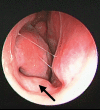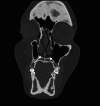The Prevalence of the Nasal Vestibular Body in Patients With Nasal Obstruction
- PMID: 38618310
- PMCID: PMC11016136
- DOI: 10.7759/cureus.56194
The Prevalence of the Nasal Vestibular Body in Patients With Nasal Obstruction
Abstract
Background and aim Nasal obstruction is one of the most common reasons for consultation addressed by otolaryngologists. There are anatomical, physiological, and pathological etiologies. Sometimes the treatment can become a challenge for the specialist, so a detailed evaluation of the etiologies must be carried out. The involvement of the nasal vestibular body (NVB) in obstructive symptoms has been described. Therefore, we must be familiar with its anatomy, presentation, and contribution to this symptomatology. This study aimed to highlight the importance of NVB in the role of nasal obstruction and know the impact that it adds to the symptoms of patients through a validated instrument on their quality of life. Material and methods A retrospective, descriptive, and analytical study was conducted on 113 patients with nasal obstruction who attended the outpatient clinic of the Otolaryngology and Head and Neck Surgery Service in a tertiary-level hospital in Monterrey, Mexico from January 2021 to January 2023. The Nasal Obstruction Symptom Evaluation (NOSE) scale was applied to assess the impact of this symptom on the quality of life of the subjects. The causes involved in the obstructive symptoms were identified by physical examination, including NVB. Two groups were made as follows: with the presence of the NVB and with the absence of the NVB, and the means of the NOSE scale were compared. Results A total of 113 patients were included, 59 male patients (52.20%) and 54 female patients (47.80%). The presence of NBV was found in 72 patients (63.70%). Other causes of nasal obstruction were found in 35 patients (31%), with chronic rhinitis being the most frequent in 27 subjects (23.90%). The mean NOSE scale score was higher in the group with the presence of the NVB than in the group with the absence of the NVB (p<0.05). The primary outcome of this study was to know the prevalence of NVB in the Hispanic population with nasal obstruction who attends the otolaryngology clinic. The secondary outcome was to know the relationship between the presence of NVB and the NOSE scores. Conclusion In this study, we observed that NVB is frequently present in patients with nasal obstruction in northeastern Mexico. There is an association between the presence of NVB and higher scores on the NOSE scale. New research will be needed to assess the effectiveness of NVB surgery in improving nasal obstruction and to determine the impact of NVB on nasal obstruction in isolation.
Keywords: concha bullosa; nasal obstruction; nasal vestibular body; septal deviation; turbinate hypertrophy.
Copyright © 2024, Trevino Gonzalez et al.
Conflict of interest statement
The authors have declared that no competing interests exist.
Figures



Similar articles
-
Nasal vestibular body treatment for recalcitrant nasal obstruction.Int Forum Allergy Rhinol. 2020 Mar;10(3):388-394. doi: 10.1002/alr.22463. Epub 2020 Feb 3. Int Forum Allergy Rhinol. 2020. PMID: 32017469
-
Nasal airway obstruction: Prevalence and anatomic contributors.Ear Nose Throat J. 2018 Jun;97(6):173-176. doi: 10.1177/014556131809700615. Ear Nose Throat J. 2018. PMID: 30036414
-
Disease-specific quality of life after septoplasty and bilateral inferior turbinate outfracture in patients with nasal obstruction.Braz J Otorhinolaryngol. 2018 Sep-Oct;84(5):591-598. doi: 10.1016/j.bjorl.2017.07.001. Epub 2017 Jul 29. Braz J Otorhinolaryngol. 2018. PMID: 28823695 Free PMC article.
-
Using the sino-nasal outcome test (SNOT-22) to study outcome of treatment of nasal obstruction.Am J Otolaryngol. 2023 Jul-Aug;44(4):103879. doi: 10.1016/j.amjoto.2023.103879. Epub 2023 Mar 28. Am J Otolaryngol. 2023. PMID: 37004319
-
Recommendation for Standardized Exam for Nasal Obstruction.Laryngoscope Investig Otolaryngol. 2025 Mar 7;10(2):e70117. doi: 10.1002/lio2.70117. eCollection 2025 Apr. Laryngoscope Investig Otolaryngol. 2025. PMID: 40061207 Free PMC article. Review.
References
-
- Nasal vestibular body treatment for recalcitrant nasal obstruction. Ibrahim N, Tyler MA, Borchard NA, Rathor A, Nayak JV. Int Forum Allergy Rhinol. 2020;10:388–394. - PubMed
-
- Anatomy and physiology of nasal obstruction. Hsu DW, Suh JD. Otolaryngol Clin North Am. 2018;51:853–865. - PubMed
-
- Nasal obstruction and quality of life assessment after septoplasty with turbinoplasty: correlation between subjective scales. Corredor-Rojas G, García-Chabur MA, Castellanos J, Moreno S, Pinzón M, Peñaranda A. Am J Rhinol Allergy. 2021;35:568–573. - PubMed
-
- Nasal anatomy and function. Patel RG. Facial Plast Surg. 2017;33:3–8. - PubMed
-
- Treatment of rhinosinusitis and histopathology of nasal mucosa: a controlled, randomized, clinical study. Bizaki AJ, Numminen J, Taulu R, Kholova I, Rautiainen M. Laryngoscope. 2016;126:2652–2658. - PubMed
LinkOut - more resources
Full Text Sources
